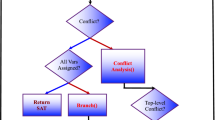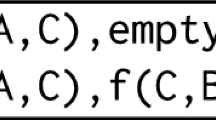Abstract
This paper describes new “lemma” and “cut” strategies that are efficient to apply in the setting of propositional Model Elimination. Previous strategies for managing lemmas and C-literals in Model Elimination were oriented toward first-order theorem proving. The original “cumulative” strategy remembers lemmas forever, and was found to be too inefficient. The previously reported C-literal and unit-lemma strategies, such as “strong regularity”, forget them unnecessarily soon in the propositional domain. An intermediate strategy, called “quasi-persistent” lemmas, is introduced. Supplementing this strategy, methods for “eager” lemmas and two forms of controlled “cut” provide further efficiencies. The techniques have been incorporated into “Modoc”, which is an implementation of Model Elimination, extended with a new pruning method that is designed to eliminate certain refutation attempts that cannot succeed. Experimental data show that on random 3CNF formulas at the “hard” ratio of 4.27 clauses per variable, Modoc is not as effective as recently reported model-searching methods. However, on more structured formulas from applications, such as circuit-fault detection, it is superior.
Similar content being viewed by others
References
O.L. Astrachan and D.W. Loveland, The use of lemmas in the model elimination procedure, J. Automated Reasoning 19 (1997) 117-141.
O.L. Astrachan and M.E. Stickel, Caching and lemmaizing in model elimination theorem provers, in: Automated Deduction — CADE-11. Proceedings of 11th International Conference on Automated Deduction, ed. D. Kapur, Saratoga Springs, NY, 15–18 June 1992 (Springer, Berlin, 1992) pp. 224-238.
M. Dalal and D. Etherington, A hierarchy of tractable satisfiability problems, Inform. Process. Lett. 44 (1992) 173-180.
S. Fleisig, D.W. Loveland, A.K. Smiley and D.L. Yarmush, An implementation of the model elimination proof procedure, Journal of the ACM 21(1) (1974) 124-139.
D.S. Johnson and M.A. Trick, eds., Cliques, Coloring, and Satisfiability: Second DIMACS Implementation Challenge, DIMACS Series in Discrete Mathematics and Theoretical Computer Science, Vol. 26 (Amer. Math. Soc., Providence, RI, 1996).
T. Larrabee, Test pattern generation using Boolean satisfiability, IEEE Trans. Comput.-Aided Design 11(1) (1992) 6-22.
T. Larrabee and Y. Tsuji, Evidence for a satisfiability threshold for random 3CNF formulas, Technical Report UCSC-CRL-92-42, UC Santa Cruz, Santa Cruz, CA (October 1992).
R. Letz, K. Mayr and C. Goller, Controlled integration of the cut rule into connection tableau calculi, J. Automated Reasoning 13(3) (1994) 297-337.
D.W. Loveland, Mechanical theorem-proving by model elimination, Journal of the ACM 15(2) (1968) 236-251.
D.W. Loveland, A simplified format for the model elimination theorem-proving procedure, Journal of the ACM 16(3) (1969) 349-363.
D.W. Loveland, Automated Theorem Proving: A Logical Basis (North-Holland, Amsterdam, 1978).
J. Minker and G. Zanon, An extension to linear resolution with selection function, Inform. Process. Lett. 14(3) (1982) 191-194.
D. Mitchell, B. Selman and H. Levesque, Hard and easy distributions of SAT problems, in: Proceedings of the 10th National Conference on Artificial Intelligence (AAAI-92), San Jose, CA (July 1992) pp. 459-465.
B. Monien and E. Speckenmeyer, Solving satisfiability in less than 2n steps, Discrete Appl. Math. 10 (1985) 287-295.
R.E. Shostak, A graph-theoretic view of resolution theorem-proving, Ph.D. thesis, Center for Research in Computing Technology, Harvard University (1974). Also available from CSL, SRI International, Menlo Park, CA.
R.E. Shostak, Refutation graphs, Artif. Intell. 7 (1976) 51-64.
J.P. Silva and K.A. Sakallah, GRASP — a new search algorithm for satisfiability, in: Proc. IEEE/ACM Int'l Conf. on Computer-Aided Design (IEEE Computer. Society Press, Los Alamitos, CA, 1996) pp. 220-227.
M.E. Stickel, Upside-down meta-interpretation of the model elimination theorem-proving procedure for deduction and abduction, J. Automated Reasoning 13(2) (1994) 189-210.
A. Van Gelder, Autarky pruning in propositional model elimination reduces failure redundancy, J. Automated Reasoning 23(2) (1999) 137-193.
A. Van Gelder and Y.K. Tsuji, Satisfiability testing with more reasoning and less guessing, in: Cliques, Coloring, and Satisfiability: Second DIMACS Implementation Challenge, eds. D.S. Johnson and M. Trick, DIMACS Series in Discrete Mathematics and Theoretical Computer Science (Amer. Math. Soc., Providence, RI, 1996).
H. Zhang, SATO: An efficient propositional prover, in: 14th International Conference on Automated Deduction (1997) pp. 272-275.
Author information
Authors and Affiliations
Rights and permissions
About this article
Cite this article
Van Gelder, A., Okushi, F. Lemma and cut strategies for propositional model elimination. Annals of Mathematics and Artificial Intelligence 26, 113–132 (1999). https://doi.org/10.1023/A:1018950727018
Issue Date:
DOI: https://doi.org/10.1023/A:1018950727018




